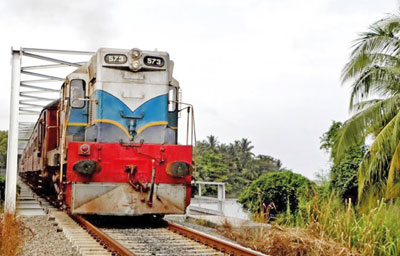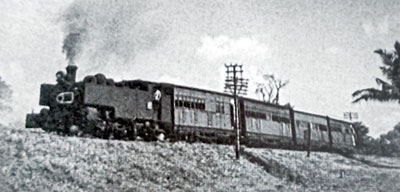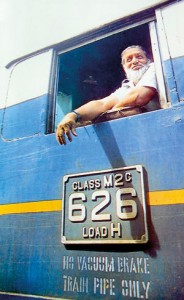Rolling back the years on the rails

Still running on the west coastline: Quebec, one of the first M2 locos donated by Canada in 1954
Trains run alongside my garden. The railway line from Colombo to the south, having been built in the late 19th Century, cuts across what was formerly a cinnamon estate reaching down to the sea, and passes by my bungalow. There are usually 14 trains a day, up and down, beginning at 4.15 a.m. and ending at 21.25. Since I’m a gricer (a rail enthusiast), I regarded that as a thrill, not an annoyance. It enables me to witness from my verandah the entire range of locomotives serving Sri Lankan Railways.
This year marks the 150th anniversary since the first train steamed into Kandy, opening up the hill country and making it possible to transport goods swiftly in a single day, instead of 12 days by bullock cart, between Kandy and Colombo. It’s a fortuitous coincidence that the railway came into service in the same year as the first commercial field of tea was planted. Without tea as freight, the railways would not have been profitable or able to expand, and without trains carrying tea to Colombo for export, the tea industry would not have developed so successfully.
The ease of transportation by railway opened up the hill country to settlers from Britain who travelled as passengers and demanded comfort and some trains became legendary for luxury. Even as recently as 1980, I travelled from Trincomalee to Colombo in a first class sleeper compartment for two complete with attached bathroom and dark red Edwardian drapes. Of course, by then the old rolling stock was decrepit but did give a hint of the fun of passenger rail travel of previous decades.
Those carriages have disappeared now, although restored traditional rail travel can still be enjoyed on the privately-operated Viceroy Express sometimes hauled by a steam locomotive, notably Sir Thomas Maitland (No. 251) built in Britain in 1928 or Frederick North (No. 340) built in 1945. No trace remains of the first engine to steam into Kandy to great excitement in 1867 although it remained in service until 1927. The passenger carriages had four wheels with the luxury of projecting sun shades, bonnet-type side ventilation, glass drop windows and a double roof with coconut oil lamps.
On October 25, 1991, the last scheduled steam-hauled passenger train left Maradana for Nugegoda. I was the only passenger. The locomotive (Number 220) was built in 1924. After that, the Narrow Gauge KV Line was converted to broad gauge and served by diesel power sets. However, diesel locomotives (Class S1) were first introduced over 50 years before, in 1938, when they operated fast services on the west coast line from Colombo to Matara.

Their descendants operate on the line today. The foremost – and oldest — are known as Canadian engines (Class M2) and have been much admired since the first ones (Numbers 569 to 573) entered service in the 1950s. Number 572, given the name British Colombia, began hauling the Ruhunu Kumari train on the coastal line on October 24, 1955. British Colombia also hauled the first Udarata Menike (Colombo to Badulla) on April 23, 1956.She is still running today, a vintage loco rivalling any classic automobile for power and beauty.
It is fitting to pay tribute to these distinctive Canadian-built locomotives for consistently serving Sri Lanka Railways for more than 60 years, longer than any other engines, whether steam or diesel. Their approach along the coast line is heralded long before one arrives. The thunder of the engine reverberates through the seaside coconut groves, audible above the noise of waves smashing on the beach. The trumpet horn atop the roof blasts at level crossings, warning of the train’s passage as it trundles along with speed and determination.
These M2s are used now to haul local trains (the ones that stop at every station) and comprise only a few old carriages.They are all marvels of engineering, and praise is due to the dedicated employees of Sri Lanka Railways who maintain them. Originally five of these durable diesel-electric locomotives, developed by General Motor Diesel Canada, were imported as a gift from Canada under the Colombo Plan.
The General Manager (1955-1970) of Ceylon Government Railways (CGR), the respected B.D. Rampala, was invited to Canada to discuss details of the specifications with the manufacturer in Ontario. Rampala himself took the first locomotive on its trial run when it arrived here.It was his idea to name the locos after Canadian Provinces in appreciation of this gift from the Government of Canada.
An article by former mechanical engineer CGR, A.R.P. Wijeyesekera published in 1989, states: “We did not look up an atlas for names. We took the names off a cushion cover,which Rampala had brought back from Canada as a memento. The names were leaked to Canada as a newspaper story and some Canadian Provinces found their name left out while their neighbours were recognised…” There were protests on behalf of those omitted.
Rampala saw this as an opportunity to get more locomotives. “Before the official handing-over ceremony, he whispered to Sir John Kotelawela that the solution was that Canada should gift more locomotives, so we could name our locomotives after all the Canadian provinces. Sir John put it across in his inimitable way in his speech of acceptance. The Canadian Ambassador did not hesitate. ‘Canada would gift more locomotives, sir.’”

Montreal and its driver on a run to Badulla, 1994
The first locomotives named from the cushion cover were Ontario (569). Alberta (570), Saskatchawan (571), British Colombia (572), and Quebec (573). Mantitoba (591), Nova Scotia (592) and New Brunswick (593) entered service in 1956 with Prince Edward Island (594) and Newfoundland (595) arriving in 1958.
Eventually 14 locomotives were donated, although there are only 10 Canadian provinces. The extra locos which arrived in 1961 were named Montreal (626) and Vancouver (627) with, in 1966, 628 named Kankesanturai as it was to be based there, and 629 named Galle. That 51-year-old loco has just passed my garden on its run from Galle to Colombo as I write this.
When they first arrived, Montreal (626) and Vancouver (627) were used exclusively for the Colombo/Badulla service and would probably still be going strong on that line if they had not been replaced by the sleek, modern but charmless Chinese-built blue diesel power coaches (S12) in 2012.
The longevity of the Canadian diesels is remarkable. Number 570, Alberta, was trapped in Kankesanturai in 1989 where it remained until 1997 when it was dismantled and shipped to Colombo to be rebuilt. It was damaged by an accident in Pothuhera but repaired. Number 571, Saskatchewan, was destroyed by a landmine in 1985. Number 628, Kankesanthurai, was also damaged by a landmine but was rebuilt.Number 591, Manitoba, was caught in the 2004 tsunami while on the coastal run but was eventually repaired.
While other diesel locomotives, many of them 50 years old and made in Germany, still serve the coast line, as do modern power sets, none have the personality of those Canadian diesel locomotives that succeeded steam engines in the 1950s. To ride in carriages with open windows and doors and wooden seats, pulled by those noisy, veteran engines stopping at every rural halt, is to recapture the essence of the time when rail travel was enjoyable, not a daily commuter chore by power set.

British cigarette card from the 1930s


